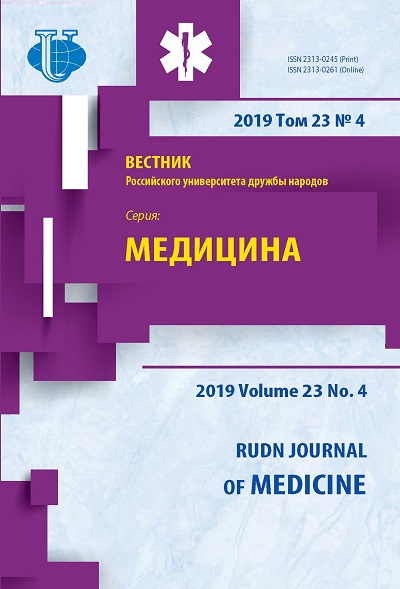Demographic characteristics of the Moscow region at the beginning of the XXI century
- Authors: Olenin Y.A.1, Lebedeva I.V.1
-
Affiliations:
- Evdokimov Moscow state medical and dental University
- Issue: Vol 23, No 4 (2019)
- Pages: 418-430
- Section: SOCIAL HEALTH AND HEALTH PROTECTION
- URL: https://journals.rudn.ru/medicine/article/view/22803
- DOI: https://doi.org/10.22363/2313-0245-2019-23-4-418-430
Cite item
Full Text
Abstract
The socio-economic development of the country and any region is influenced by many factors, among which the most important role belongs to the demographic, in a generalized form representing the demographic situation. The demographic situation is usually understood as the demographic situation, the state of demographic processes, the composition and placement of the population at a certain time in a country or a particular region. Thus, the analysis of the demographic situation is necessary for understanding the main parameters of the population, trends in their dynamics, forecasting the number, demographic structure, demographic behavior of the population. Objective: to conduct a comparative analysis of official statistical data on demographic processes (statics and population dynamics) in the Moscow region (MO) for 2000-2015. Materials and methods: at the first stage, the collection and analysis of information and statistical sources were carried out, requests were sent to the Federal and territorial state statistics services of the Russian Federation (Rosstat, Mosobstat, MIAC MO). At the second stage, the data on demographic processes in the Moscow region were copied from the responses of Rosstat, Mosobstat, MIAC MO and from the websites of relevant organizations. Statistical analysis included calculation of simple arithmetic mean, percentage values, economic and demographic burden on the working population, demographic factors and the efficiency of population growth. Results and conclusions. The population of the Moscow region at the beginning of the XXI century continues to increase, but mainly due to migrants arriving from neighboring regions of the country and abroad. Males constitute 46.2% of the population and females 53.8% (2015). Boys are born more than girls by 6% and this advantage is maintained until the age of 30. And starting from the age of 35, the number of women begins to prevail over the number of men by 3.5%. This trend continues to 75 years and older. Age groups of the region's population are formed according to the regressive type: children - 15.9%; working-age population - 59.8%, and persons older than working age - 24.3% (2015). The economic and demographic burden of children and the elderly on the working population is more than 40%. The birth rate in the region increased by 76.7% from 2000 to 2015 and was higher than in 1990. Analysis of the total fertility rate indicates that in the Moscow region remains mononuclear family type (1-2-child family), ie there is no expanded reproduction of the population. In children, and especially in working age, the mortality rate is higher in men than in women. In men, the mortality rate reaches 41% of the total mortality at the working age. The number of women who died in working age is 4 times less than men. The natural increase in the population of the Moscow region for 15 years of the XXI century has a small but negative value, since the population is decreasing, and the increase in the population is mainly due to high migration.
Keywords
About the authors
Y. A. Olenin
Evdokimov Moscow state medical and dental University
Author for correspondence.
Email: jarosol@mail.ru
Moscow, Russian Federation
I. V. Lebedeva
Evdokimov Moscow state medical and dental University
Email: jarosol@mail.ru
Moscow, Russian Federation
References
- Schepin OP, Medic VA. Health of the region’s population and health priorities. Moscow:Geotar-Media; 2010. 384 p. (In Russ.)
- Malkhazova SM, Semenova VYu, Shartova NV, Gurov AN. Health of the population of the Moscow region. Medical and geographical aspects. Moscow: GEOS; 2010. 110 p. (In Russ.)
- Official website of the Federal state statistics service. Available from: http://www.gks.ru (In Russ.)
- Demographic Yearbook of Russia. 2000. Statistical handbook. Moscow: Rosstat; 2001. 242p. (In Russ.)
- Demographic Yearbook of Russia. 2010. Statistical handbook. Moscow: Rosstat; 2011. 557p. (In Russ.)
- Demographic Yearbook of Russia. 2015. Statistical handbook. Moscow: Rosstat; 2016. 321p. (In Russ.)
- Medical and demographic indicators of the Russian Federation in 2016. Statistical handbook. Moscow: Ministry of health of Russia; 2017. 254p. (In Russ.)
- Medik VA, Tokmachev MS. Guide to Health and Health Statistics. Moscow: Medicine; 2006. 528p. (In Russ.)
- Kolesnikov BL. The state of health and demographic processes in the Orenburg region at the beginning of the XXI century. Ed. Lebedeva IV. Moscow: Medicine; 2007. 168p. (In Russ.)
- Lebedev AA, Lebedeva IV, Zhusjanov OT. Basis for the development of society — investment in human health. Alma-Ata; 1986. 233p. (In Russ.)
- Volkov VV. State of health of the population and demographic processes of municipal industrial formation of the subject of the Russian Federation: on the example of municipal formation-Togliatti. Orenburg; 2013. 51p. (In Russ.)
- Kurman MV. Actual issues of demography. Moscow: Statistics; 1976. 220p. (In Russ.)
- Milovidov AS. Years of life and years of work. Moscow: Finance and statistics; 1983. 117p.
- WHO. World statistics. Report “Life expectancy and Healthy life expectancy”. Country data. 2016. Available from: https://apps.who.int/gho/data/node.main.688
- Coleman D. Immigration and Ethnic Change in Low-fertility Countries: A Third Demographic Transition. (Statistical data.) Population and Development Rev. 2006 Sept; 32(3): 401—46. Available from: https://doi.org/ 10.1111/j.1728-4457.2006.00131.x
- Easterlin R. The Birt Dearth, Aging, and the Economy. In: Asefa S, Huang WCh, editors. Human Capital and Economic Development. Kalamazoo: MI: W. E. Upjohn Inst. for Employment Research; 1994. p.11—35. Available from: https://research.upjohn.org/cgi/viewcontent.cgi? article=1198&context=up_press
- Lanzieri G. Is Fertility Converging across the Member States of the European Union? Eurostat, Work Session on Demographic Projections. Lisbon; 2010. 137p.
















